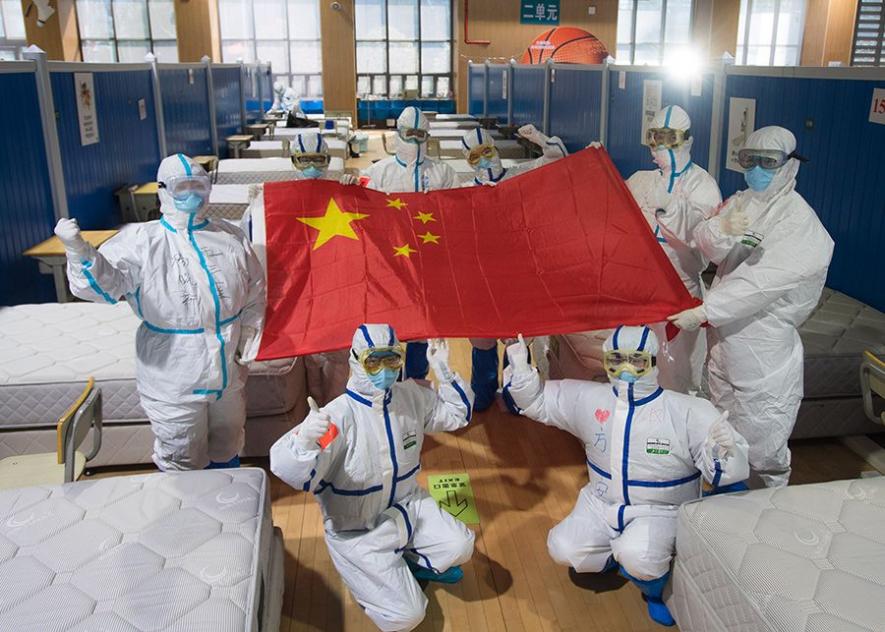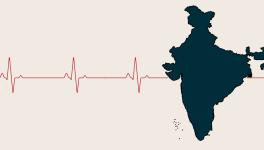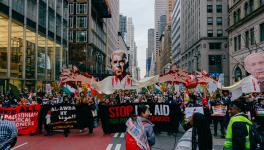Secret of China’s Success -- Clear Goals, Granular Planning

Medical workers pose for photos after seeing cured patients off at the Wuchang temporary hospital in Wuhan, central China's Hubei Province, March 10, 2020. - Xinhua
They were as swift as kung fu fighters, as strong as fiery dragons.
As China emerges out of the COVID-19 crisis and India goes under a confused state of lockdown, it is important to understand the diverse, multi-pronged and holistic ways in which Beijing's policymakers handled, what turned into, a global pandemic. Although China's management of the disease that emerged in the city of Wuhan in late December 2019, has been criticised severely in the Western media, there may be some valuable lessons for Indian administrators here.
On the national stage, China was able to undertake gigantic mobilisation of men and machinery to build entire hospitals in record time. It unleashed the strength of its state-owned enterprises, created policy and administrative frameworks where private companies - from AI (artificial intelligence) start-ups to hosiery units -- stepped in to play crucial roles.
At the micro level, China raised an army of volunteers and professionals to ensure that citizens observe lockdown norms, maintain home quarantine, while keeping them supplied with food and essentials. Despite initial blunders and public anger, the Chinese government kept moving swiftly in a 360 degree manner that finally brought COVID-19 under control.
In context of India dealing with a humongous tragedy resulting from an abrupt, blanket national lockdown, it may be fruitful to examine some of the policy and logistical measures China took to keep 1.4 billion people safe.
Lockdown: One by One
It is important to remember that the entire country did not go under lockdown at the stroke of midnight. Instead, it was the city of Wuhan, capital of landlocked Hubei province in central China with a population of 11 million, which was the first to face a total and strict lockdown from January 23.
As is common knowledge now, the virus first emerged in this city in late December and was tracked down after dozens of people were observed to be contracting pneumonia from an unknown source. On January 11, China confirmed the first novel coronavirus death of a 61-year-old man who had visited the Wuhan live animals market; it took them another 12 days to put in place aggressive containment measures -- but only for a single city.
From January 23, the government barred people from leaving or entering Wuhan. Initially, trains and flights to the city were cancelled and stringently monitored, checkpoints were set up on roads leading into the province. Next, public transportation systems in areas surrounding Wuhan went under lockdown and traveling restriction extended to the rest of Hubei province. One by one, 15 cities were shut down, affecting more than 50 million people.
It is imperative to understand that the total lockdown of Wuhan, and later Hubei province, was based entirely on the number of people getting affected by the novel coronavirus, while the rest of China was put under highest emergency, based on threat perception.
China follows at least three levels of emergency response -- medium, severe, most severe. From January 25, the high population cities of Shanghai, Beijing and at least 24 other regions were put under 'most severe' level of emergency. On February 2, Wenzhou, in the prosperous Zhejiang province in East China, implemented a seven-day lockdown. At no point was a total lockdown imposed on the entire country.
China fought this epidemic with complete cooperation from its people. It started with closing public places, closing businesses, slowing down and sanitising transport and establishing checkpoints across the country. Cases were tracked meticulously and people who potentially had a contact with a virus source were informed and their self-isolation ensured. Temperature checks still remain common before entering residential neighbourhoods, shopping malls, and office spaces. Grocery stores take down names and phone numbers of customers.
There was, however, no uniform diktat laid down by Beijing -- different provinces and cities placed regulations depending on their perceived level of danger. For instance, in Wuhan, the lockdown meant, only one person per household was allowed to exit once in two days (except for medical reasons or to work at shops and pharmacies) whereas movement in Shanghai remained relatively free.
Next, after continuously monitoring the status of every resident in Hubei province and the most vulnerable cities, and when new confirmed virus cases started dwindling, the government started lifting restrictions. Controls were lessened in an incremental manner, permit requirements for transport removed and entry/exit controls from various cities eased. By March 13-14, the entire Hubei province was declared 'low risk' or 'medium risk'. Now, only Wuhan and Beijing remain at 'highest emergency response level'. The cooling off period is being done in a highly controlled manner, with schools and restaurants still shuttered.
Information : More the Better
Despite accusations of China hiding the true extent of the disease, it quickly got its act together and ensured that its people were not left guessing and floundering. Government officials gave precise, timely information about numbers of suspected, confirmed patients, those quarantined at local hospitals or those ordered to stay home.
The Western media has constantly harped on fears of the surveillance state extending its grip on citizens at this time, but there is also a democratic side to this. The Chinese people are now used to viewing the world through audio visual images , they expect public officials to remain visible and on camera while discharging their duties; they are expected to be seen and heard, their performance is closely monitored and discussed threadbare online. For instance, when Shanghai went under emergency, a whole range of officials from the Director of Shanghai Preventive Medicine Association to the Director of the Shanghai Municipal Health Commission gave constant briefing, putting out a steady stream of data and information about disease spread. Contrary to popular perception of an opaque state, the fact is, public officials in China must create an impression that loads of useful information is being put out in the public domain and is up for scrutiny.
Needless to say, to feed the tech-guzzling Chinese consumer, innumerable platforms immediately opened up to disseminate information and health advice in real time. An intelligent bilingual newsbot, developed by artificial intelligence start-up, Zhuiyi Technology, which can answer questions about novel coronavirus in English and Mandarin, was launched on China Daily's App and became quickly popular.
Baidu created special maps on locations for confirmed and suspected cases of the virus, Qihoo 360 launched a platform where travellers can check if anyone on their recent train or plane trips has since tested positive, so that they could take appropriate self-quarantine measures. Chinese online platforms also spent considerable energy fighting misinformation, fake news, myths and rumours which travelled faster than pathogens. Tencent “Medipedia,” a healthcare encyclopaedia, has kept up a running battle to prevent people from falling victim to quackery.
State-sanctioned information, combined with a plethora of apps and digital platforms constructed by smart, young start-ups, kept millions of Chinese calm and connected to the outside world, during their months of restriction.
Transport: Slow it Down but Keep Moving
The world is now familiar with eerie images of empty Chinese mega cities, but intensive planning and war-scale work went into keeping cities quarantined, yet kicking. China introduced sweeping containment measures -- shutting down cities one after the other -- at a time when millions of people travel to their hometowns because of the Chinese New Year. While inter-city and inter-province movement slowed down heavily, and caused untold misery to millions, at no point did the government put a complete halt to flight, train or Metro services.
During a lockdown, or emergency, when every resident is ordered to stay indoors, an entire army of invisible warriors must continue to work to keep cities alive. It is critical to ensure that there is enough supply of materials, including surgical masks, disinfectant, protective suits and safety goggles for the frontline medical workers, vegetables, groceries, meats for common people. It is the state's duty to ensure that this invisible army of people can get to their place of work, which is why empty Metro trains and buses plied the entire day for these 'civilian soldiers'.
More complex was handling inter-city communications. Transport administrators, along with police personnel and thousands of city volunteers, launched detection checkpoints at entrances and exits of cities, enforcing non-negotiable rules to contain movement from Hubei provinces and other affected regions.
To cite an example of how the wheels kept moving in North China -- transport authorities in Beijing, Tianjin and neighbouring Hebei province set up an information-sharing mechanism to ensure smooth and co-ordinated operation along various transportation channels, such as highways, railways and aviation. They organised special vehicles to pick up out-of-state workers and send them directly to their workplaces in the region. This was done to ensure that essential services to millions of home-bound people are not disrupted and daily necessities, including vegetables and instant food, could be delivered.
Strict vigil was maintained to ensure that vehicles transporting passengers could use no more than half their capacity, use only designated roads and stop at permitted stations to avoid transmission of the virus during trips.
To keep its supply chains running, China was able to unleash the power of its state-owned corporations, its IT giants and e-commerce goliaths to maintain smooth operations for two months. While China Telecom and Huawei jointly set up a 5G-enabled remote video diagnostic centre, which enabled medical staff to conduct online consultations with potential patients, Alibaba’s grocery chain remained open for business, proving to be a life-saver. Its logistics arm, Cainiao Smart Logistics Network, teamed up with dozens of logistics partners to launch a “Green Channel” initiative that ensured fast and safe delivery of medical supplies from around the world to Chinese provinces.
As for air travel, unlike US and India, China did not ban travel from any country. On February 2, the United States banned all travel from China, except for journeys by its own citizens. Australia and a few other countries have since followed suit.
India, too, has banned flights from more than 30 countries until April 15. However, as data shows and according to the World Health Organisation, travel bans do not always work. Even though China has not banned travel from any countries, the number of new cases has declined drastically over time. This was possible only by enforcing strict monitoring at airports. In places like Shandong in North East China, which saw a large number of flights from South Korea, which was also badly affected, the authorities enforced stringent isolation policy, with dedicated buses transporting travellers to quarantine sites. Travellers from Italy, Japan, the US, and other high-risk countries are also being quarantined.
An epidemic of this scale poses endless challenges that require multi-faceted responses -- catastrophically simple solutions, like halting trucks and banning air travel simply don't work.
Build Hospitals, Manufacture Masks
From hospitals to masks -- the speed at which China constructed and manufactured, blasting away bureaucratic sloth, is nothing short of spectacular.
Much has been written about the temporary hospitals built in Wuhan, especially the 1,000-bed Huoshenshan hospital, constructed between January 24 and February 4. At every stage, what is visible is the Chinese state's control over the economy, over companies, men and material movement.
China can get gargantuan projects done, relying as it does, on a top-down mobilisation approach that can overcome bureaucratic hurdles and mobilise every available resource. For the Wuhan hospital, at least 7,500 workers were deployed, more than thousand kinds of mechanical equipment harnessed and experts from the China Construction Third Engineering Bureau, Wuhan Construction Engineering Group, Wuhan Municipal Engineering Group and Hanyang Municipal Engineering put in complete charge.
Beijing China IPPR International Engineering's design for the hospital was cleared in precisely 78 minutes. Within an hour, CITIC General Institute of Architectural Design and Research convened 60 designers with experience in overseeing mega scale public welfare projects. Hundreds of architects across the country were contacted and asked to come up with a floor plan within 24 hours. They were given another 60 hours to work with the construction unit to finalise the blueprint.
Even as designs were being drawn up, the Wuhan Airport Development Group swiftly moved in for site leveling, building approach roads and putting together drainage systems. An emergency engineering construction team was put together, which included leading enterprises from both government and private sector to handle anti-seepage works, sewage treatment and medical waste transfer facilities.
China Railway Construction Heavy Industry Corporation and the State Electricity Grid provided 260 power workers who worked round the clock. Before January 31, the relocation of two 10kV lines, the placement of 24 box-type transformers, and the laying of 8,000 meter power cables were completed and power transmission lines established.
Meanwhile, Huawei, China Mobile, China Telecom, China Unicom, China Tower, China Electronics, China Information Communication Technologies Group Corporation and other front and back enterprises worked closely to complete 5G signal coverage in 36 hours, deliver computing and storage equipment of cloud resources and core systems, and build a remote consultation system with the PLA General Hospital.
Live broadcast of the construction site was organised. The construction machinery was provided by Chinese multinationals, Sany Heavy Industry, Zoomlion Heavy Industry and XCMG machinery. State-owned companies CNPC provided on-site fuel truck, while Sinopec Zhiyin Avenue guaranteed fuel supply. By February 4, patients were being wheeled in.
While all this was being carried out in Wuhan, local governments had ordered millions of people to wear masks -- a non-negotiable item for all residents. This meant, masks had to be prepared on a war-footing. Mask factories started running at 110% capacity, even as units that once made shoes and garments were retooled. Machines that churned out fibrous materials for diapers and sanitary pads started producing high-grade materials for masks. Innerwear factories and bedding companies transformed their manufacturing lines to start mask production.
Even a pharmaceutical group, Shengjingtong, was one of the thousands of companies that transitioned to become part of China's mask-making army. Aided by generous government subsidies, within 11 days, they were making more than 10,000 N95 masks a day. By mid-March, China was making 200 million face masks a day — more than 20 times the amount it made at the start of February. Of this, 6,00,000 are N95 standard masks, used by medical personnel and healthcare workers.
The uniqueness of Chinese manufacturing is their ability to change horses mid-stream and reboot entire factories and machinery for an entirely different purpose. This talent ensured, every Chinese had access to a steady supply of disposable masks, a luxury impossible in any other country.
Science & State
Finally, China was able to conduct a precision containment policy in a country of 1.4 billion people because it tackled the problem with science and humanity. They had clear goals -- the spread of virus had to be contained and stopped, normal life needed to come to a halt and residents needed to stay indoors. They had to be kept safe, healthy, well-fed; anger and desperation needed to be kept at bay. It was not a matter of getting them to wear face masks, wash hands or self-isolate. It was a matter of treating infected people and curing them. As of now, of the 81,118 people confirmed infected in China, 68,800 have recovered.
Along the way, China ensured that effective and convenient testing devices and reagents were distributed, which allowed more people to be tested and treated swiftly. Artificial intelligence, big data and other technologies were used to trace the movements of those infected and mathematically draw up models of how the epidemic might develop.
A country's response to an outbreak of a communicable disease, its use of technology and handling its population humanely depends on the ideological orientation of its policymakers. The Chinese state moved like kung fu experts. Can India replicate this response?
The writer is a journalist based in Shanghai. Views are personal.
Get the latest reports & analysis with people's perspective on Protests, movements & deep analytical videos, discussions of the current affairs in your Telegram app. Subscribe to NewsClick's Telegram channel & get Real-Time updates on stories, as they get published on our website.
























